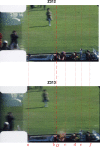Gunshot-wound dynamics model for John F. Kennedy assassination
- PMID: 29736430
- PMCID: PMC5934694
- DOI: 10.1016/j.heliyon.2018.e00603
Gunshot-wound dynamics model for John F. Kennedy assassination
Erratum in
-
Corrigendum to "Gunshot-wound dynamics model for John F. Kennedy assassination" [Heliyon 4 (2018) e00603].Heliyon. 2018 Oct 1;4(10):e00831. doi: 10.1016/j.heliyon.2018.e00831. eCollection 2018 Oct. Heliyon. 2018. PMID: 30294686 Free PMC article.
Abstract
U.S. President John F. Kennedy was assassinated while riding in an open motorcade by a sniper in Dallas, Texas on 22 November 1963. A civilian bystander, Mr. Abraham Zapruder, filmed the motorcade with a 8-mm home movie camera as it drove through Dealey Plaza, inadvertently recording an ≈8 second sequence of events that included a fatal gunshot wound to the President in the head. The accompanying backward motion of the President's head after impact appeared to support later "conspiracy theories" because it was claimed that this was proof of a shot from the front (in addition to one from behind). In this paper, simple one-dimensional dynamical models are uniquely applied to study in detail the fatal shot and the motion of the President's head observed in the film. Using known parameters from the crime scene, explicit force calculations are carried out for determining the projectile's retardation during tissue passage along with the resulting transfer of momentum and kinetic energy (KE). The computed instantaneous KE transfer within the soft tissue is found to be consistent with the formation of a temporary cavity associated with the observed explosion of the head, and subsequent quantitative examination of this phenomenon reveals two delayed forces at play in the backward motion of the President following impact. It is therefore found that the observed motions of President Kennedy in the film are physically consistent with a high-speed projectile impact from the rear of the motorcade, these resulting from an instantaneous forward impulse force, followed by delayed rearward recoil and neuromuscular forces.
Keywords: Mechanics; Physics.
Figures








Similar articles
-
The Unique and Misunderstood Wound Ballistics in the John F. Kennedy Assassination.Am J Forensic Med Pathol. 2019 Dec;40(4):336-346. doi: 10.1097/PAF.0000000000000510. Am J Forensic Med Pathol. 2019. PMID: 31688051
-
Computational ballistic analysis of the cranial shot to John F. Kennedy.Forensic Sci Int. 2022 May;334:111264. doi: 10.1016/j.forsciint.2022.111264. Epub 2022 Mar 8. Forensic Sci Int. 2022. PMID: 35305439
-
A neuroforensic analysis of the wounds of President John F. Kennedy: Part 2--A study of the available evidence, eyewitness correlations, analysis, and conclusions.Neurosurgery. 2004 Jun;54(6):1298-310; discussion 1311-2. doi: 10.1227/01.neu.0000125870.74214.6c. Neurosurgery. 2004. PMID: 15157287
-
Why Did the Earwitnesses to the John F. Kennedy Assassination Not Agree About the Location of the Gunman?Front Psychol. 2021 Nov 16;12:763432. doi: 10.3389/fpsyg.2021.763432. eCollection 2021. Front Psychol. 2021. PMID: 34867663 Free PMC article. Review.
-
The Assassination of Abraham Lincoln and the Evolution of Neuro-Trauma Care: Would the 16th President Have Survived in the Modern Era?World Neurosurg. 2015 Nov;84(5):1453-7. doi: 10.1016/j.wneu.2015.06.011. Epub 2015 Jun 17. World Neurosurg. 2015. PMID: 26092530 Review.
Cited by
-
Icy Intrigue: A Case Report of an Unusual Encounter With an Ice Pick Injury.Cureus. 2023 Jun 22;15(6):e40805. doi: 10.7759/cureus.40805. eCollection 2023 Jun. Cureus. 2023. PMID: 37485086 Free PMC article.
References
-
- Wrone D.R. 2013th edition. University Press of Kansas; Lawrence, KS: 2003. The Zapruder Film: Reframing JFK's Assassination.
-
- Warren Commission Hearings . 1964. Hearings Before the President's Commission on the Assassination of President Kennedy, vol. VII.
-
- Warren Commission Report . 1964. Report of the President's Commission on the Assassination of President Kennedy.
-
- Bugliosi V. 1st edition. W. W. Norton & Company, Inc.; New York, NY: 2007. Reclaiming History: The Assassination of President John F. Kennedy.
-
- Ayton M., Von Pein D. Strategic Media Books, LLC; Rock Hill, SC: 2014. Beyond Reasonable Doubt: The Warren Report and Lee Harvey Oswald's Guilt and Motive 50 Years on.
LinkOut - more resources
Full Text Sources
Other Literature Sources

